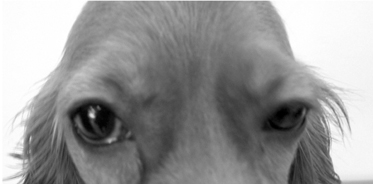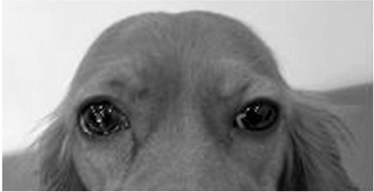J Vet Sci.
2008 Mar;9(1):117-119. 10.4142/jvs.2008.9.1.117.
Acupuncture treatment for idiopathic Horner's syndrome in a dog
- Affiliations
-
- 1Animal Disease Research Unit, College of Life Science and Natural Resources, Wonkwang University, Iksan 570-749, Korea. kimoj@wonkwang.ac.kr
- 2Center for Animal Resources Development, Wonkwang University, Iksan 570-749, Korea.
- 3Family Animal Clinic, Gunsan 573-351, Korea.
- KMID: 1102963
- DOI: http://doi.org/10.4142/jvs.2008.9.1.117
Abstract
- A one-year-old female English Cocker Spaniel dog with idiopathic Horner's Syndrome is described. The specific clinical signs in this specimen were miosis, ptosis, enophthalmos, and prolapsed nictitans for 2 days following sudden onset. According to history taking, ophthalmic, neurological, and radiological examination, the patient was diagnosed with idiopathic Horner's syndrome. Manual acupuncture treatment was applied to the dog on local points two times in 2 days. The local acupoints were ST-4 (Di Chang) and GB-1 (Tong Zi Liao). The day after the initial acupuncture treatment, clinical signs related to idiopathic Horner's syndrome had almost disappeared. The day after the second treatment, specific clinical signs were completely absent. During this period, the dog did not receive any orthodox treatment. Thus, it is suggested that manual acupuncture might be an effective therapy for idiopathic Horner's syndrome.
Keyword
MeSH Terms
Figure
Reference
-
1. Carlsson C. Acupuncture mechanisms for clinically relevant long-term effects- reconsideration and a hypothesis. Acupunct Med. 2002. 20:82–99.
Article2. George ND, Gonzalez G, Hoyt CS. Does Horner's syndrome in infancy require investigation? Br J Ophthalmol. 1998. 82:51–54.
Article3. Herrera HD, Suranit AP, Kojusner NF. Idiopathic Horner's syndrome in collie dogs. Vet Ophthalmol. 1998. 1:17–20.
Article4. Im PO, Yolton RL. Concepts of traditional oriental medicine. Optometry. 2000. 71:621–629.5. Jeong SM. Electroacupuncture treatment for idiopathic trigeminal nerve paralysis in a dog. J Vet Clin Med. 2001. 18:67–69.6. Kern TJ, Aromando MC, Erb HN. Horner's syndrome in dogs and cats: 100 cases (1975-1985). J Am Vet Med Assoc. 1989. 195:369–373.7. Kimura K, Masuda K, Wakayama I. Changes in skin blood flow and skin sympathetic nerve activity in response to manual acupuncture stimulation in humans. Am J Chin Med. 2006. 34:189–196.
Article8. Liu J, Jiang D, Yu M, Yang J. Observation on 63 cases of facial paralysis treated with acupuncture. Zhen Ci Yan Jiu. 1992. 17:85–86.9. Lynch JH, Keneally RJ, Hustead TR. Horner's syndrome and trigeminal nerve palsy following epidural analgesia for labor. J Am Board Fam Med. 2006. 19:521–523.
Article10. Mirzai H, Baser EF. Congenital Horner's syndrome and the usefulness of the apraclonidine test in its diagnosis. Indian J Ophthalmol. 2006. 54:197–199.
Article11. Morgan RV, Zanotti SW. Horner's syndrome in dogs and cats: 49 cases (1980-1986). J Am Vet Med Assoc. 1989. 194:1096–1099.12. Mori H, Nishijo K, Kawamura H, Abo T. Unique immunomodulation by electro-acupuncture in humans possibly via stimulation of the autonomic nervous system. Neurosci Lett. 2002. 320:21–24.
Article13. Panciera RJ, Ritchey JW, Baker JE, DiGregorio M. Trigeminal and polyradiculoneuritis in a dog presenting with masticatory muscle atrophy and Horner's syndrome. Vet Pathol. 2002. 39:146–149.
Article14. Peng S, Wang S, Zhao JH. Clinical observation on point-through-point therapy of scalp electroacupuncture for treatment of facial spasm. Zhongguo Zhen Jiu. 2006. 26:563–565.15. Qin ML. Chinese Acupuncture and Moxibustion. 1993. New York: Churchill Livingstone;3–4.16. Qiu XH, Xie XK, Xie K. Point-through-point acupuncture for treatment of peripheral facial paralysis. Zhongguo Zhen Jiu. 2006. 26:287–289.
- Full Text Links
- Actions
-
Cited
- CITED
-
- Close
- Share
- Similar articles
-
- Horner's Syndrome Secondary to Epidural Anaesthesia Following Posterior Instrumented Scoliosis Correction
- Unilateral Horner's Syndrome following supraclavicular brachial plexus block
- Painful Horner syndrome after thyroidectomy: A case report
- Bilateral Horner's Syndrome after a Stellate Ganglion Block
- Acute Central Horner Syndrome Diagnosed by 0.5% Apraclonidine Test: The Usefulness of the Apraclonidine Test




